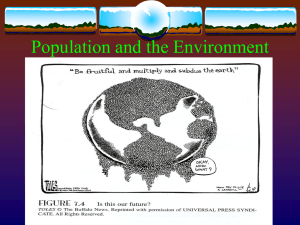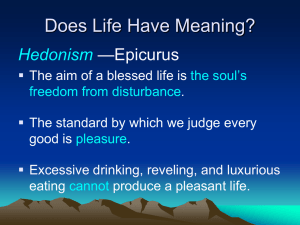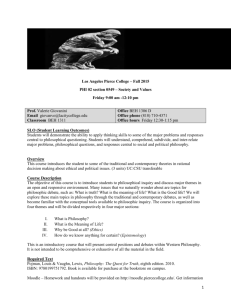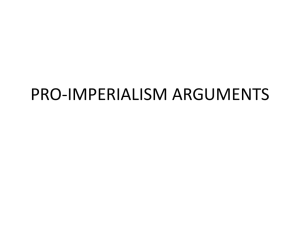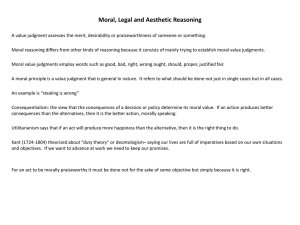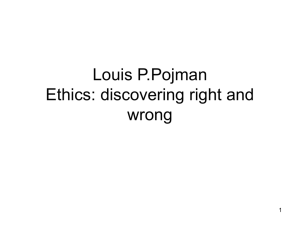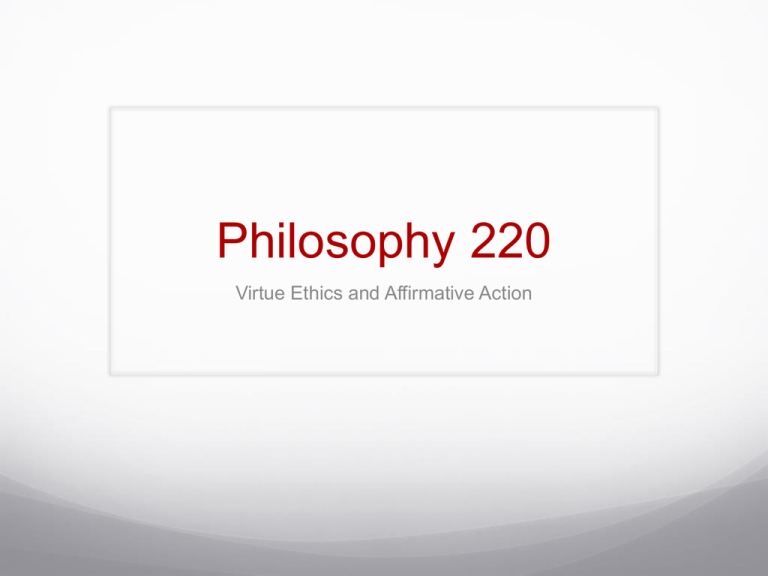
Philosophy 220
Virtue Ethics and Affirmative Action
Character vs. Acts
Though historically speaking, Virtue Ethics is the
first systematic, philosophical ethical position, it
had until somewhat recently been pushed aside by
the other ethical theories we’ve studied.
One reason for this is that these other theories
have focused our attention on the ethical
evaluation of acts, while VE focuses on character.
There are lots of (not necessarily all good) reasons
to prefer the former.
An Ethic of Virtue
The lack of attention (until recently) paid to VE has
the result that there is still a great deal of
disagreement about the basic structure of VE.
We can say a few basic and uncontentious things
about such theories.
The first and most important one is the VE
reverses the tendency that we’ve seen in other
ethical theories and makes the concepts of virtue
and vice basic.
Right and Wrong become derivative concepts.
Virtue and Vice
Virtue: “a trait of character or mind that typically
involves dispositions to act, feel, and think in
certain ways and that is central to a positive
evaluation of persons” (25).
Honesty, Courage, Justice, Temperance, Beneficence
Vice: “a trait of character or mind that typically
involves dispositions to act, feel and think in
certain ways, and that is central to a negative
evaluation of persons” (26).
Dishonesty, Cowardice, Injustice, Intemperance, Selfishness
A TRC for Virtue Ethics
On the basis of the distinction between virtues and
vices, it is possible to articulate a general TRC for VE.
An action is right iff it is what a virtuous agent (acting in
character) would not avoid doing in the circumstances under
consideration.
If a virtuous agent would do it, the action is obligatory; if
they might do it, the action is permissible; if they
wouldn’t do it, the action is forbidden.
“Acting in character” points to the concept of “practical
wisdom” and the significance of moral
judgment/intuition for VE.
Advantages of VE
It is consistent with our moral intuition that
there may be more than one right answer in the
face of a moral dilemma.
It is not inconsistent with our conviction that
traits of character are importantly out of our
control, inasmuch as they are influences by
genetics and circumstance.
It encourages us to take a holistic view of our
moral circumstances.
Disadvantages?
What about the virtues and vices
themselves?
Who is a virtuous agent?
How do we know if they are “acting in
character?”
What if we lack a virtuous character?
Some Conceptual Clarification
Affirmative Action refers to any of a range of proactive
attempts to correct inequalities due to race, biological sex,
etc., by taking positive action on behalf of those who are
disadvantaged.
In the strict sense, AA refers to programs designed to
ensure that there is no discrimination in employment or
education and, instead, equal opportunity exists.
When they go so far as to include enhancing the applicant
pool by recruiting and supporting well-qualified candidates
from the disadvantaged class, AA programs are
characterized as Procedural Affirmative Action.
Beyond Affirmative Action
AA is typically distinguished from Preferential
Treatment programs in which the disadvantaged
characteristic is made a criterion of participation.
Another approach is what has become known as a
Quota System in which the inclusion of a specified
number of individuals with the characteristic is
mandated.
A typically less offensive approach is the Set-Aside in
which new opportunities are created for such
individuals.
Justifying Affirmative Action
There are a number of very common arguments
justifying AA programs, as well as PT, QS or SA.
1. Justice Arguments. Historically, people from specific groups have
been discriminated against. Classic AA is aimed at those programs.
2. Role-Model Arguments. Part of participating in an occupation and
opportunity is seeing it as a real possibility. Role models make that
possible.
3. Forward-Looking. AA creates opportunities for disadvantaged groups.
4. Backward-Looking. AA serves as reparation for historical oppression.
Pojman on AA
Though Pojman’s title suggests that his criticism is
wide-ranging, he actually addresses only preferential
treatment programs.
One explanation for the gap is that while he thinks that
strict and/or procedural AA programs are morally
acceptable, he isn’t confident that they can be
administered appropriately.
With regard to PT programs, he considers and rejects
both forward and backward looking justifications.
Forward-Looking Justifications
The metaphor which Pojman chooses to
characterize F-L justifications is that of the “level
playing field.”
The argument is essentially that continuing
economic and social disparities between whites
and non-whites have wide-ranging negative
implications for non-whites in economic and social
competitions. In the face of these systemic and
historical disparities, AA (or as Pojman would have
it, PT) is justified on the basis of fairness.
The Issue is Class not Race
Pojman first of all acknowledges the extent and
character of the disparities, between the poor
and wealthy in our society.
What this justifies, he thinks, is not PT based
on race, but on class.
This PT should include: need based education
assistance; using class as a tie breaker.
The Laundry List
Pojman then goes on to take a scatter shot
approach to criticizing PT based on race.
All the old favorites are here:
PT causes stigmatization and sets people up to fail.
PT produces a degradation in standards.
I didn’t need PT.
PT really doesn’t benefit the poor.
People shouldn’t expect equal results because they are
not equal (all sorts of questionable ethnic
generalizations).
PT is a disincentive to responsible parenting.
Forward-Looking Justifications
Fail
Given these concerns, Pojman thinks that F-L
justifications don’t succeed.
Even if they did, however, Pojman insists that
the discussion would not be over.
This type of argument is essentially
consequentialist, and thus is open to objections
from the perspective of justice.
Remember the justice objection to
consequentialism?
Backward-Looking Justifications
The argument in favor of AA (or PT) is that
historical harms inflicted on Americans of
African descent by Americans of European
descent require some sort of reparation and PT
is an appropriate way of satisfying this
obligation.
As Pojman discusses this argument, the focus
is the question of under what circumstances
compensation is required.
Pojman on Compensation
The model that Pojman employs is what we could
call agent-compensation.
Agent A harms Agent B in some specific way C. The obligation to
compensate is relative to the relation between A and B as reflected in
the nature of C.
Pojman is willing to extend this model to the social
or group level, but only when it is possible to
identify groups relevantly like agents.
Criteria include: well-defined groups, specifiable harms.
The Case of African-American
Reparation
On the basis of his account of compensation,
Pojman has serious reservation about the
adequacy of the justification of PT for Americans of
African descent based on historical wrongs.
States with specific discriminatory statutes may be liable, but not the
U.S. government.
Much of the discriminatory harm was perpetrated by individuals, not
states.
Not all blacks were harmed and not necessarily more than other
‘immigrant’ populations.
Even if we could apply the compensation model to this case, it’s not
clear that PT is an appropriate compensation.
Still…
Pojman acknowledges that the agentcompensation model may not be sufficient (case of
undeterminable agent) and thus B-L justifications
may succeed.
Even if they do, however, at most what they justify
is AA, not PT.
We don’t know what would happen in the counterfactual case.
Competence is prima facie preferable in the case of important goods.
Arbitrariness.
Those Who Harm Should Pay
Pojman’s rejection of B-L justifications
seems to fly in the face of our intuition that
those people who harm and unjustly benefit
should pay the price.
Pojman’s response is to insist that the
benefit current members of society realize
from past patterns of discrimination is
unintended and it would be unfair to impose
an obligation to discharge this harm on
them.
Reverse Discrimination
A similar concern motivates his insistence that
PT amounts to reverse discrimination.
“Respect for persons entails that we treat each
person as an end in himself or herself, not
simply as a means to be used for social
purposes…What is equally wrong about
Affirmative Action is that it fails to treat White
males with dignity as individuals, judging them
by both their race and gender, instead of their
merit” (280c2).
Hill “The Message of Affirmative
Action”
Hill’s approach to the question of the moral status of AA
is much different from Pojman’s.
Though he too is critical of both forward and backward
looking arguments justifying AA, he doesn’t dispute the
force or scope of such arguments, but rather what
these arguments suggest about the nature of racism or
sexism.
These arguments send the wrong message about
racism and sexism, but other arguments, particularly
ones that focus on the narrative realities of racism and
sexism get the job done.
The Wrong Message: ForwardLooking Arguments
Considering first forward-looking arguments for affirmative action, Hill
focuses on their typical employment of consequentialist justification.
Hill identifies a number of problems with this approach.
Legitimate questions have been raised about the capacity of AA to bring about the
desired consequences.
Focus on the consequences of AA programs requires us to include analysis of
potentially undesirable consequences like those highlighted by Pojman.
Most importantly, even if the consequences are in some desirable, the subtext of this
approach implies that the individual who benefits is merely being used to bring about
a desired consequence.
Missing in this type of analysis is any account of the history or racism and
sexism in this country, or of the continuing racist and sexist realities that
we live in.
The focus is on producing a certain end, not on why the end is morally desirable or
obligatory.
The Wrong Message: BackwardLooking Arguments
Hill then turns to backward-looking arguments, which
have tended to focus on the existence of a prima facie
duty to reparation for past harms.
Here too, Hill acknowledges the force of arguments like
Pojman’s which have questioned the moral legitimacy
of reparative efforts.
Once again, however, it is the underlying message with
which he is most concerned, a message which in this
case implies that the individual who benefits is selfcentered, merely “grasping for limited 'goodies’
(286c2)”
Elements of An Alternative
Hill suggests an alternative approach to issues like AA,
grounded in a different understanding of the dimensions of
moral analysis than typically employed by traditional moral
theory.
Values as “cross-time wholes” (287c1) reflect the historical
character of our moral lives.
Dependency of our evaluative concepts on history.
Relevance of context.
The whole is often greater than the parts.
The alternative: “examin[ation of] lives and relationships,
over time, in context, as organic unities evaluated (partly) in
narrative terms’ (288c2).
Example of John and Mary.
What does this mean for AA?
How does the example of John and Mary serve as the basis
for a justification of affirmative action?
An approach to affirmative action consistent with the
alternative detailed by Hill would appeal to values such as
“having a history of racial and gender relations governed, as
far as possible, by the ideal of mutual respect, trust, and fair
opportunity for all” (289c1).
In this context, we have a narratively complex and morally
adequate story to tell about AA that addresses itself
meaningfully to all affected parties, that speaks to these
central values (cf. 290c1-2).


